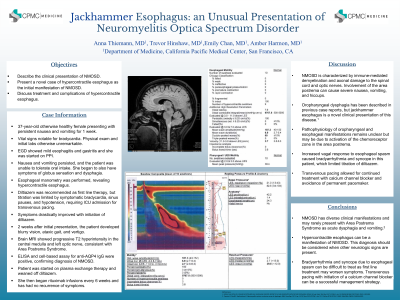Monday Poster Session
Category: Esophagus
P2298 - Jackhammer Esophagus: An Unusual Presentation of Neuromyelitis Optics Spectrum Disorder
Monday, October 28, 2024
10:30 AM - 4:00 PM ET
Location: Exhibit Hall E

- AT
Anna Thiemann, MD
California Pacific Medical Center
San Francisco, CA
Presenting Author(s)
Award: Presidential Poster Award
Anna Thiemann, MD
California Pacific Medical Center, San Francisco, CA
Introduction: Neuromyelitis Optica Spectrum Disorder (NMOSD) is a rare autoimmune inflammatory demyelinating disorder that affects the CNS. Hypercontractile (Jackhammer) esophagus is a presentation of this disorder that has not previously been described, highlighting unique diagnostic and therapeutic challenges.
Case Description/Methods: This is a case of a 37-year-old otherwise healthy female who presented to the hospital with persistent nausea, vomiting, dysphagia, and globus sensation for 1 week, with vital signs notable for marked bradycardia.
EGD which showed mild esophagitis and gastritis. Esophageal manometry then revealed at least two swallows with distal contractile integral (DCI) >8000, mean > 5000, and elevated wave amplitude and duration, consistent with a diagnosis of hypercontractile esophagus. Diltiazem was recommended as first line therapy, but titration was limited by concomitant symptomatic bradycardia, sinus pauses, and hypotension requiring ICU admission for trans venous pacing (TVP).
2 weeks after her initial presentation, the patient then developed blurry vision, ataxic gait, and vertigo while in the hospital. MRI brain revealed a central medullary enhancing lesion consistent with Area Postrema Syndrome, and questionable mild left sided optic neuritis. ELISA and Cell-Based Assay for anti-AQP4 IgG eventually resulted as positive, confirming the diagnosis of NMOSD. The patient was then started on plasma exchange and weaned off of diltiazem prior to discharge. She has since been receiving rituximab infusions every 6 weeks and has had no recurrence of symptoms.
Discussion: NMOSD has diverse clinical manifestations, and may rarely present with isolated gastrointestinal symptoms in early stage disease. This case outlines the importance of considering neurological causes when evaluating GI complaints. Dysphagia, nausea, and vomiting frequently occur in NMOSD with medulla oblongata involvement, but jackhammer esophagus has not previously been described in association with this neurologic disorder. The pathophysiology of this is unclear, but may be due to activation of the chemoreceptor zone in the area postrema. This patient’s course was also complicated by bradyarrhythmia and syncope, thought due to vagal response to the diffuse esophageal spasm, which limited the titration of diltiazem. We demonstrate that TVP can be a successful temporary management approach to allow for continued treatment with calcium channel blocker, leading to improvement in this patient's symptoms.
Disclosures:
Anna Thiemann, MD. P2298 - Jackhammer Esophagus: An Unusual Presentation of Neuromyelitis Optics Spectrum Disorder, ACG 2024 Annual Scientific Meeting Abstracts. Philadelphia, PA: American College of Gastroenterology.
Anna Thiemann, MD
California Pacific Medical Center, San Francisco, CA
Introduction: Neuromyelitis Optica Spectrum Disorder (NMOSD) is a rare autoimmune inflammatory demyelinating disorder that affects the CNS. Hypercontractile (Jackhammer) esophagus is a presentation of this disorder that has not previously been described, highlighting unique diagnostic and therapeutic challenges.
Case Description/Methods: This is a case of a 37-year-old otherwise healthy female who presented to the hospital with persistent nausea, vomiting, dysphagia, and globus sensation for 1 week, with vital signs notable for marked bradycardia.
EGD which showed mild esophagitis and gastritis. Esophageal manometry then revealed at least two swallows with distal contractile integral (DCI) >8000, mean > 5000, and elevated wave amplitude and duration, consistent with a diagnosis of hypercontractile esophagus. Diltiazem was recommended as first line therapy, but titration was limited by concomitant symptomatic bradycardia, sinus pauses, and hypotension requiring ICU admission for trans venous pacing (TVP).
2 weeks after her initial presentation, the patient then developed blurry vision, ataxic gait, and vertigo while in the hospital. MRI brain revealed a central medullary enhancing lesion consistent with Area Postrema Syndrome, and questionable mild left sided optic neuritis. ELISA and Cell-Based Assay for anti-AQP4 IgG eventually resulted as positive, confirming the diagnosis of NMOSD. The patient was then started on plasma exchange and weaned off of diltiazem prior to discharge. She has since been receiving rituximab infusions every 6 weeks and has had no recurrence of symptoms.
Discussion: NMOSD has diverse clinical manifestations, and may rarely present with isolated gastrointestinal symptoms in early stage disease. This case outlines the importance of considering neurological causes when evaluating GI complaints. Dysphagia, nausea, and vomiting frequently occur in NMOSD with medulla oblongata involvement, but jackhammer esophagus has not previously been described in association with this neurologic disorder. The pathophysiology of this is unclear, but may be due to activation of the chemoreceptor zone in the area postrema. This patient’s course was also complicated by bradyarrhythmia and syncope, thought due to vagal response to the diffuse esophageal spasm, which limited the titration of diltiazem. We demonstrate that TVP can be a successful temporary management approach to allow for continued treatment with calcium channel blocker, leading to improvement in this patient's symptoms.
Disclosures:
Anna Thiemann indicated no relevant financial relationships.
Anna Thiemann, MD. P2298 - Jackhammer Esophagus: An Unusual Presentation of Neuromyelitis Optics Spectrum Disorder, ACG 2024 Annual Scientific Meeting Abstracts. Philadelphia, PA: American College of Gastroenterology.

